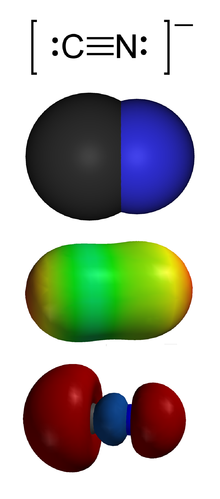
| |
| Names | |
|---|---|
| Systematic IUPAC name
Nitridocarbonate(II) | |
| Identifiers | |
3D model (JSmol)
|
|
| ChEBI | |
| ChemSpider | |
PubChem CID
|
|
| UNII | |
| |
| |
| Properties | |
| CN− | |
| Molar mass | 26.018 g·mol−1 |
| Conjugate acid | Hydrogen cyanide |
| Hazards | |
| Occupational safety and health (OHS/OSH): | |
Main hazards
|
The cyanide ion CN− is one of the most poisonous chemicals. It may cause death in minutes. |
Except where otherwise noted, data are given for materials in their standard state (at 25 °C [77 °F], 100 kPa).
| |
In chemistry, cyanide (from Greek kyanos 'dark blue') is a chemical compound that contains a C≡N functional group. This group, known as the cyano group, consists of a carbon atom triple-bonded to a nitrogen atom.[1]
In inorganic cyanides, the cyanide group is present as the cyanide anion −C≡N. This anion is extremely poisonous. Soluble salts such as sodium cyanide (NaCN) and potassium cyanide (KCN) are highly toxic.[2] Hydrocyanic acid, also known as hydrogen cyanide, or HCN, is a highly volatile liquid that is produced on a large scale industrially. It is obtained by acidification of cyanide salts.
Organic cyanides are usually called nitriles. In nitriles, the −C≡N group is linked by a single covalent bond to carbon. For example, in acetonitrile (CH3−C≡N), the cyanide group is bonded to methyl (−CH3). Although nitriles generally do not release cyanide ions, the cyanohydrins do and are thus toxic.
- ^ "cyanides". IUPAC Gold Book. 2014. doi:10.1351/goldbook.C01486.
- ^ "Environmental and Health Effects of Cyanide". International Cyanide Management Institute. 2006. Archived from the original on 30 November 2012. Retrieved 4 August 2009.